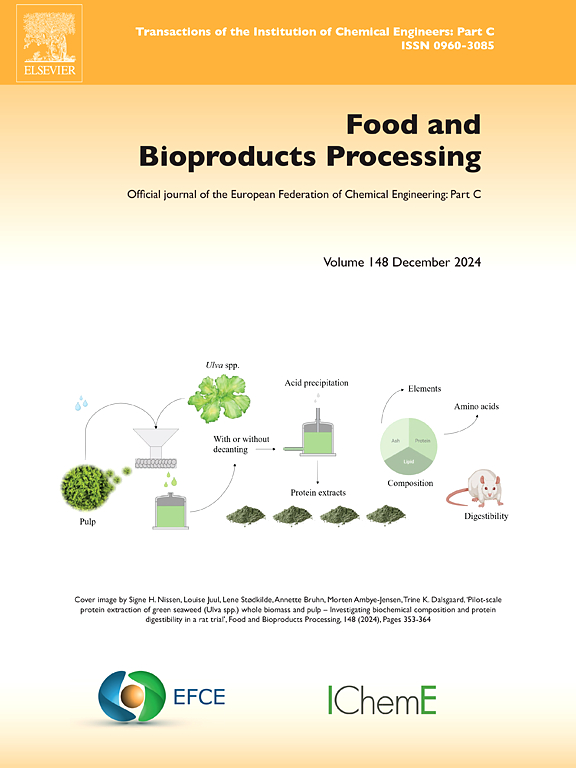Multi-method evaluation of surimi quality from a bycatch species (Trachurus lathami): Physicochemical, textural, sensory, and thermal responses to washing conditions
IF 3.4
2区 农林科学
Q2 BIOTECHNOLOGY & APPLIED MICROBIOLOGY
引用次数: 0
Abstract
The valorisation of underutilised fish species, such as Trachurus lathami, presents an opportunity to diversify fishery products. This study investigates the physicochemical, textural, sensory, and thermal properties of T. lathami surimi, comparing washed and unwashed samples while considering variables such as mince size, washing solution composition, and washing solution-to-fish ratio. Minced T. lathami exhibited high protein (0.181 g·g−1) and moisture (0.754 g·g−1) content, supporting its suitability as a raw material for surimi production. Main effects analysis revealed that finer mincing (4 mm) enhanced the removal of lipids, pigments, and volatile compounds, reducing fat, a* value (redness), total volatile basic nitrogen (TVBN), and thiobarbituric acid reactive substances (TBARS). A similar effect was observed with increased washing solution ratio, though it also led to lower protein and ash retention. The second alkaline saline washing cycle effectively mitigated moisture overload, improved protein retention, and reduced cooking loss, thereby supporting improved structural and functional properties. Unwashed fish mince was more resistant to puncture, with higher hardness and force at break values, whereas washed samples—particularly those treated with alkaline saline solutions—were softer and more deformable, as confirmed by texture profile analysis. Differential scanning calorimetry (DSC) suggested the removal of sarcoplasmic proteins and increased myosin and actin enthalpy, indicating structural rearrangements. Flash Profile analysis identified key sensory attributes, including cohesiveness, succulence, hardness, and fish flavour, with washed samples showing reduced fish flavour and improved juiciness. This study highlights T. lathami as a valuable raw material for surimi production, with washing playing a crucial role in enhancing its properties and supporting the development of sustainable, value-added seafood products.
用多种方法评价副渔获物种鱼糜的质量:对洗涤条件的理化、质地、感官和热反应
未充分利用的鱼类,如拉塔米沙龙的价值增值,提供了使渔业产品多样化的机会。本研究考察了鲣鱼的物理化学、质地、感官和热性能,比较了洗涤和未洗涤的样品,同时考虑了碎肉大小、洗涤溶液组成和洗涤溶液与鱼的比例等变量。鱼糜具有较高的蛋白质含量(0.181 g·g−1)和水分含量(0.754 g·g−1),适合作为鱼糜原料。主效应分析显示,更细的切碎(4 mm)增强了脂质、色素和挥发性化合物的去除,降低了脂肪、a*值(发红)、总挥发性碱性氮(TVBN)和硫代巴比妥酸活性物质(TBARS)。随着洗涤液比例的增加,也观察到类似的效果,尽管它也导致蛋白质和灰分保留率降低。第二个碱性盐水洗涤循环有效地减轻了水分过载,改善了蛋白质的保留,减少了蒸煮损失,从而支持改进的结构和功能特性。未经清洗的鱼糜更耐刺穿,在破裂值具有更高的硬度和力,而洗涤后的样品-特别是用碱性盐水溶液处理的样品-更柔软,更易变形,这一点得到了纹理剖面分析的证实。差示扫描量热法(DSC)显示肌浆蛋白去除,肌球蛋白和肌动蛋白焓升高,表明结构重排。Flash Profile分析确定了关键的感官属性,包括粘性、多汁性、硬度和鱼味,洗涤后的样品显示鱼味降低,多汁性提高。这项研究强调了鲣鱼是生产鱼糜的一种有价值的原料,水洗在提高其性能和支持可持续、增值海鲜产品的发展方面起着至关重要的作用。
本文章由计算机程序翻译,如有差异,请以英文原文为准。
求助全文
约1分钟内获得全文
求助全文
来源期刊

Food and Bioproducts Processing
工程技术-工程:化工
CiteScore
9.70
自引率
4.30%
发文量
115
审稿时长
24 days
期刊介绍:
Official Journal of the European Federation of Chemical Engineering:
Part C
FBP aims to be the principal international journal for publication of high quality, original papers in the branches of engineering and science dedicated to the safe processing of biological products. It is the only journal to exploit the synergy between biotechnology, bioprocessing and food engineering.
Papers showing how research results can be used in engineering design, and accounts of experimental or theoretical research work bringing new perspectives to established principles, highlighting unsolved problems or indicating directions for future research, are particularly welcome. Contributions that deal with new developments in equipment or processes and that can be given quantitative expression are encouraged. The journal is especially interested in papers that extend the boundaries of food and bioproducts processing.
The journal has a strong emphasis on the interface between engineering and food or bioproducts. Papers that are not likely to be published are those:
• Primarily concerned with food formulation
• That use experimental design techniques to obtain response surfaces but gain little insight from them
• That are empirical and ignore established mechanistic models, e.g., empirical drying curves
• That are primarily concerned about sensory evaluation and colour
• Concern the extraction, encapsulation and/or antioxidant activity of a specific biological material without providing insight that could be applied to a similar but different material,
• Containing only chemical analyses of biological materials.
 求助内容:
求助内容: 应助结果提醒方式:
应助结果提醒方式:


